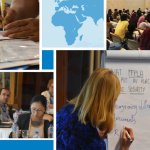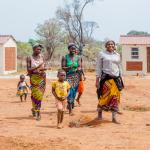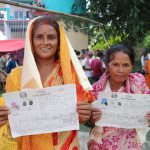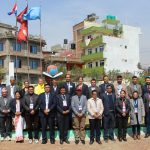The Global Land Tool Network (GLTN) is dynamic and multisectoral alliance of international partners committed to increasing access to land and tenure security for all, with a particular focus on the poor, women and youth. The Network’s partners include international rural and urban civil society organizations, research and training institutions, bilateral and multilateral organizations, and international professional bodies.
We develop, disseminate and implement pro-poor and gender-responsive Land Tools. These tools and approaches contribute to land reform, good land governance, inclusive land administration, sustainable land management, and functional land sector coordination.
Secure land tenure and property rights are fundamental to accessing adequate housing, food security and livelihoods. Land tenure security is crucial for the realization of human rights, poverty reduction, economic prosperity and sustainable development leading to the attainment of the Sustainable Development Goals, the New Urban Agenda and other regional and country level policy initiatives.
The prioritised core values for GTLN Strategy 2018-2030 are:
- Social justice and equity
- Strength in diversity
- Reciprocity
- Transparency
The operational principles that have long underpinned GLTN are:
- Pro-poor
- Equitable
- Gender responsive
- Affordable
- Sustainable
- Systematically scaleable.
Approaches to land and tenure security must take into consideration the complexities of people’s customs and culture, gender, life stage course, administrative, and development contexts. We advocate for land tenure that best suits the social, cultural and economic needs of local communities along with the needs of responsible land administration authorities.
- The Continuum of Land Rights Approach: Our approach to inclusive, good land governance is based on the Continuum of Land Rights Approach to tenure security. The Continuum of Land Rights is a concept or metaphor for understanding and administering the rich complexity of land rights on the ground. It is estimated that the conventional land governance systems in many developing countries covers only about 30% of land. This reaches small proportion of the population and does not respond to the majority needs. There exists a broad range of land rights, such as individual, informal, customary, or group rights, that can be recognized, strengthened and used to improve access to land and tenure security. Recognition of this important reality is at the heart of our work. More Information
- Fit-for-Purpose Land Administration: We understand that land is handled differently in different places and contexts so there needs to be an adaptive element within this inclusive framework. In other words, approaches must be “fit for purpose”. In most developing countries, conventional land titling approaches have largely failed to deliver their expected results. Existing technical solutions are either too expensive, are inappropriate for the different types of land tenure in developing countries, are financially unsustainable, require a high level of technical capacity, or are largely unavailable. The Fit-for-Purpose Land Administration Approach was developed in response to such challenges. It proposes to re-focus land administration to meet the needs of people and their relationship to land,while sustainably managing land-use and natural resources. The Approach promotes the use of flexible and pragmatic approaches that are affordable easy to establish and maintain, that are built on existing available technical, financial and human capacities, rather than responding to rigid, high-end requirements. More Information
- Partnership and collaboration: We believe in the power of collaboration and value partnerships and collaboration as a fundamental way of undertaking our work. The collective inputs of different stakeholders and institutions engender change and develop inclusionary approaches. When all key voices and perspectives are heard, these approaches generate innovative solutions that sustainably deliver change for those who most need it. Sustainable worldwide change in the way land is managed in countries and communities cannot be achieved by individual organizations, no matter how powerful and well-funded. Access to land and tenure security for all, including the poor and women, requires the aligned and well-coordinated action of all land actors. Our Network of the civil society, professional institutions, research and training organizations, bilateral and multilateral agencies, governments and the private sector address this requirement. Click here for more information on the organizations that are part of GLTN.
- A flexible and inclusive view of land tenure based on the Continuum of Land Rights.
- A range of innovative land tools designed in line with proven standards and good practice, including fit-for-purpose land administration.
- A focus on pro-poor, gender- and youth-responsive approaches.
- A recognition of the interconnections between urban, peri-urban and rural land.
- A dynamic international partnership involving key land actors and stakeholders.
This involves:
- The ability to undertake concerted multi-disciplinary, multi-level, cross-sectoral and inclusive initiatives at local, national and international levels, as tailor-made and sustainable responses to specific land access and tenure security challenges.
- Innovative, affordable and adaptable land tools to support and complement (or, where necessary, replace) existing land administration systems to deliver land tenure security in urban, peri-urban and rural contexts. These tools also serve as a means of implementation for the fulfilment of states’ obligations under relevant treaties, general principles and norms in international human rights law.
- Flexible methodologies and capacity development programmes at all levels that combine and bridge the political, social, human and technical dimensions that are essential for responsible land administration.
- Well-tested, in-country modus operandi which involve and empower local and national actors such as grassroots groups, communities, civil society, governments, the private sector, relevant professions, local and national governments and the United Nations to use land tools for tenure security.
- Through GLTN’s alignment with the UN system through UN-Habitat, use the convening power and mandates of the United Nations system).
Our partners work together to improve tenure security for as many people as possible through:
- Developing new knowledge on tenure security such as our inclusive land tenure approach that recognizes various forms of tenure, and that involves stakeholders in seeking solutions that are fair and just to all,
- Testing, demonstrating and disseminating land tools that are practical, innovative and designed to solve problems related to land tenure with the aim of achieving wide use and integration at policy levels,
- Adopting a good learning practice approach to our work and undertaking capacity development including training and mentoring individuals, national and local government institutions, local communities and other stakeholders to develop, adapt and strengthen their land governance systems, and
- Advocating for improved tenure security for all towards fostering understanding and building capacity on the land monitoring agenda.
GLTN Partners are grouped into clusters based on the nature of their organization. There are currently four clusters:
- International Professional Bodies
- International Training and Research Institutions
- International Rural Civil Society Organizations
- International Urban Civil Society Organizations.
Click here for more information on GLTN partners.
The GLTN Secretariat is hosted by UN-Habitat and it is based in the Land and GLTN Unit at the UN-Habitat headquarters in Nairobi, Kenya. The Secretariat is responsible for the day-to-day operations of the programme and over-all Network coordination.
The Individual Members of GLTN are those individuals who registered on the GLTN website and join GLTN to be affiliated with the Network and receive GLTN updates and information, join e-forums and web discussions when available, access e-libraries and participate in the open section of the bi-enniel GLTN Partners Meeting. Click here to become a GLTN member!
As part of ensuring a vibrant and effective Network, the organizational arrangements of the Global Land Tool Network were reviewed in 2018 and a new set of arrangements developed in response to partners feedback. The Network now has an inclusive Steering Committee comprising partners represented by the dual leaders of the 4 main clusters, development partners, and supported by the GLTN Secretariat. The Steering Committee is Chaired by the Deputy Executive Director of UN-Habitat, Mr Victor Kisob and the Vice-Chair is Ms Mino Ramaroson of the Huairou Commission.
Two individuals representatives from different organizations within each of the clusters groups are nominated as the Partner Representatives to the GLTN Steering Committee. These representatives are also the cluster co-leads.
The current Partner representatives and cluster co-leads on the GLTN Steering Committee are:
- The Rural International Civil Society Organizations Cluster: Mino Ramaroson from Huairou Commission and Mr Don Marquez, ANGOC
- The Urban International Civil Society Organizations Cluster: Rebecca Ochong, Habitat for Humanity International and Ms Sarah Nandudu, Slum Dwellers International.
- The International Research and Training Institutions Cluster: Siraj Sait from the University of East London (UEL) and Uchendu Eugene Chigbu* (TUM)
- The International Professional Bodies Cluster: Diane Dumashie from the International Federation of Surveyors (FIG) and Rafic Khouri, Arab Union of Surveyors.
*affiliated with Namibia University of Science and Technology (NUST) effective October 2020
Become a GLTN Partner GLTN programme has so far had two cycles: Phase 1 (2006–2011) and Phase 2 (2012–2018).
GLTN programme has so far had two cycles: Phase 1 (2006–2011) and Phase 2 (2012–2018).
GLTN Phase 3 programme (2019-2023) was developed with a conscious application of the gender lens for a human rights-based approach to programming.
A key new feature of Phase 3 is a decisive move away from simply demonstrating the local impact to more institutionalized and strategic scale-up of the GLTN land toolbox for country-wide implementation. Phase 3 will therefore involve empowering, sharing knowledge and building partners’ and governments’ capacity to appropriately implement our land tools, and to fill the technical solutions gap.
Phase 3 implementation will address the tenure security issues of women, youth and vulnerable groups in;
- Informal settlements and slums
- Urban-rural nexus
- Indigenous and customary settings
- Land and conflict contexts
- Climate change
The programme is jointly implemented by GLTN partners and the Secretariat. The Secretariat, hosted by UN-Habitat in the Land and GLTN Unit of the Urban Legislation, Land and Governance Branch, will facilitate the administrative and financial aspects of the programme.
Infographic: Phase 3 Programme Results Chain
More information on GLTN’s Strategy 2018-2030 and GLTN Phase 3 : 2019-2023









